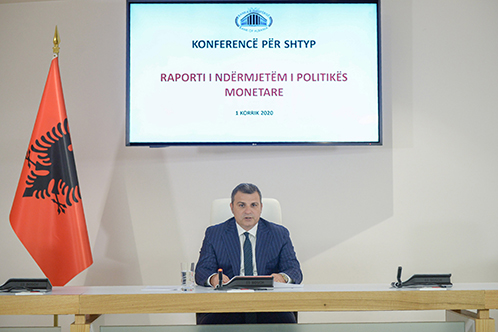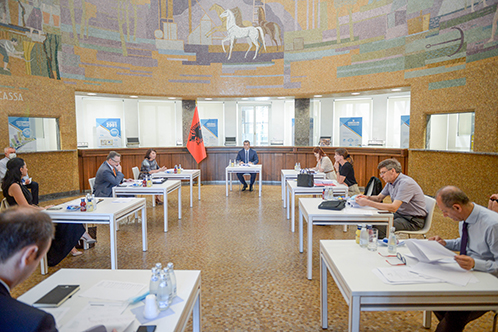BANK OF ALBANIA
PRESS RELEASE
Governor Sejko: Statement to the Press Conference on Monetary Policy Decision, 1 July 2020
Publication date: 01.07.2020
Dear Ladies and Gentlemen,
Today, on 1 July 2020, the Supervisory Council of the Bank of Albania reviewed and approved the Intermediate Monetary Policy Report.
The analysis of the available information shows that the Albanian economy has been hardly affected by coronavirus (Covid-19) pandemic over the second quarter. These consequences are still present. The reduction of both domestic and foreign demand and the disruption of manufacturing and services activities in Albania have driven to the drop of production, increase of unemployment and financial difficulties to Albanian enterprises and households. Nevertheless, the banking sector in Albania remains sound and financial markets appear relatively calm.

The Supervisory Council deems that the progressive opening of economy, the easing of social distancing measures and the stable monetary and financial environment of Albania, establish the premises for a gradual recovery of economic activity in the next quarters. However, the balance of risks remains on the down side.
Against this backdrop, the Supervisory Council judged that the current mix of fiscal, monetary and financial policies provide the necessary stimulus for supporting the economic growth and the convergence of inflation to the target.
***
The coronavirus (Covid-19) pandemic caused a comprehensive shock on the Albanian economy. Its consequences have started to be already reflected on the available statistical information.
According to Instat data, the economic activity in Albania contracted by 2.5% in the first quarter of this year, by reflecting the drop in exports and investments. Also, data of labour market show that the Albanian economy suffered around 17000 job losses in this period, while the unemployment rate increased to 11.4%

Indirect data for the second quarter show that the shock is strengthened further. Exports of goods shrunk by 33% during the first two months of this quarter, in response to the fall of foreign demand. Also, imports reduced by around 30%, by signalling the rapid slowdown of consumption and investments in Albania, while budget revenues contracted by around 30% in the first two months of this quarter, in reflection of the overall drop of the economic activity.
Against this background, inflation increased slightly in April and May. Its average rate jumped to 2%, mainly due to the temporary supply-side shocks in this period.
The Bank of Albania assesses that the future performance of economy will depend on the duration of pandemic consequences and on the reaction of both domestic and foreign economic agents against them.
Our baseline scenario of the expected developments rests upon the assumption for avoidance of a second wave of pandemic and its gradual reduction up to the complete disappearance of its consequences. In this scenario, the Albanian economy is expected to record a sharply drop in 2020 and further relatively fast and stable growth rates. The slowdown of economic activity in Albania is expected to peak in the second quarter, to continue to remain in negative territory in the next two quarter, and return to grow in 2021.
In accordance with this scenario, inflation is expected to stay close to the current rates in the second half of 2020. Further, this indicator is expected to gradually increase during the next year and converge towards the target at the end of year.
This economic performance will be sustained by an accommodative mix of economic policies.
The fiscal packages being undertaken so far have helped in alleviating the crisis consequences. The Bank of Albania expects a revision of budget for the second part of year. This revision is expected to result in a higher fiscal deficit. We have already emphasised that fiscal policy should play a key role in addressing the challenge we are facing. The prudential and temporary increase of public debt is an acceptable compromise to mitigate the effect of this shock on the economy and to support the monetary and financial stability of Albania.
In parallel, the Bank of Albania has adopted easing monetary and financial policies.
- The cut of policy rate at the historical minimum and the increase of liquidity injections, have provided for the control of risk premia and have kept the interest rates at low levels.
- In parallel with them, the regulatory measures that we have undertaken have encouraged the temporary extension of credit payments for clients in difficulties and the restructuring of credits to clients who appear with solid business perspectives, but facing short and medium-term financial difficulties. Also, these measures have aimed at increasing the use of electronic payments and have provided the normal supply of economy with cash.
In response to these measures, the financial markets appear calm. The financing cost of the private sector is close to its historical minimum, the exchange rate is stable, while banking sector continues to show good indicators of liquidity and capitalisation. In particular, the non-performing loans ratio dropped to 1.8% in May, a further fall compared with the previous quarter.
The Supervisory Council assesses that the banking sector is exercising its cushion function against shocks to the economy. This sector has continued to credit the private sector of the economy, and particularly that of enterprises. Lending to private sector continued to grow in April and May. This growth was present mainly to enterprises, by sustaining them with the necessary liquidity to deal with the crisis. Also, the banking sector has undertaken a part of the financial cost of the shock, by further easing the burden to both public and private sectors.
The Supervisory Council, by encouraging the continuation of this role, notes that the banking sector cannot and should not face alone the financial burden of this shock. In this context, the public sector has and should play a primary role, through the strengthening of fiscal stimulus, as well as the private sector through the heightening of both financial care and operational effectiveness
***
At the conclusion of discussions, based on these considerations about the projections of baseline scenario and the balance of risks surrounding it, the Supervisory Council deems that the current monetary policy stance is adequate. In this view, the Supervisory Council decided to:
- Keep the policy rate unchanged, at 0.5%;
- Keep the overnight deposit and overnight lending rates, unchanged at 0.1% and 0.9%, respectively.
The monetary policy stance will continue to remain accommodative throughout the forecast horizon.
However, the Supervisory Council judges that the balance of risks remains on the down side. In particular, the downside risks arise from:
- The return of pandemic in the form of a second wave;
- Creation of problems in monetary policy transmission mechanism, in the form of: increased interest rates and financing costs to private sector; worsened credit supply; strong fluctuations of the other indicators of the financial market.
The Supervisory Council assesses that the possibility on the materialisation of these risks is mitigated, driving to a reduction of the need to increase the monetary stimulus and use of the monetary policy non-conventional instruments. Nevertheless, the materialisation of these risks might dictate a further easing of the monetary policy stance, and potentially the use of non-conventional instruments, always in compliance with the legal framework that regulates the activity of the Bank of Albania.

 Twitter
Twitter
 Youtube
Youtube
 Facebook
Facebook
 Flickr
Flickr
 RSS
RSS
 Subscribe
Subscribe
 Feedback
Feedback